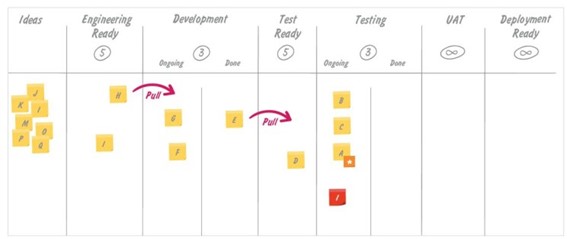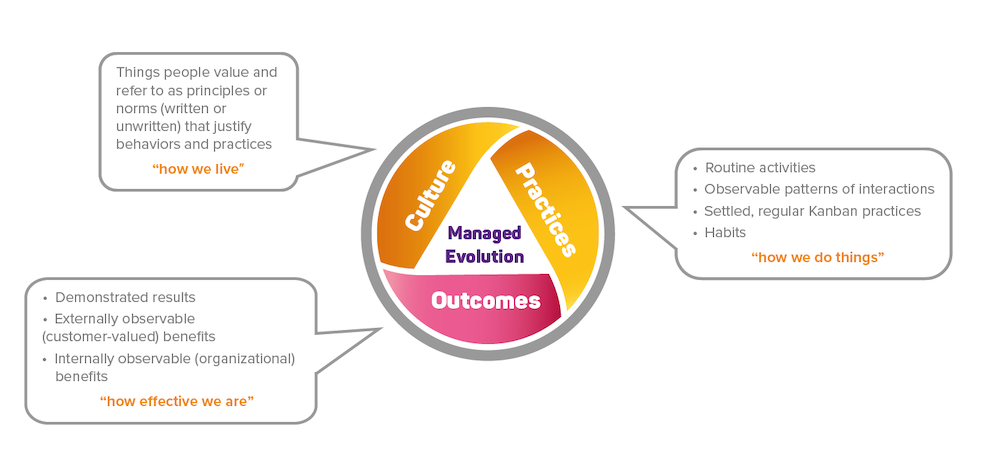
In mid-2023, David J. Anderson announced the completion of his new book “Discovering Kanban: The Evolutionary Path to Enterprise Agility”. The Spanish version has been published at the end of 2023 and is now available from Amazon and other book stores.
I have had the honour of translating this work into Spanish, and through this article, I aim to provide you a brief personal review to encourage you to read it.
The Kanban Method and the Kanban Maturity Model today represent a large and mature body of knowledge, fundamental in management, leadership, and business agility. According to David, Kanban has “come of age” and its effectiveness is well-proven. Although all of its content is now available in Kanban+, a new, comprehensive and up-to-date official work that serves as the main reference on Kanban was essential.
Firstly, It’s important to note that this is not a stand-alone book, but is the first in a series of four titled “Better with Kanban”. “Discovering Kanban” serves as a crucial introduction to Kanban and is vital to understand the subsequent volumes: “Implementing Kanban”, “Coaching Kanban” and “Scaling Kanban”, offering the most comprehensive view of the Kanban Method.
David`s intention was not merely to update the well-known Blue Book “Kanban: Successful Evolutionary Change for Your Technology Business” (2010), his aim was to offer a much more in-depth and contemporary work. “Discovering Kanban” is thus much more than a successor or a new edition of the Blue Book.
Nearly two decades into the development of the Kanban Method, there was a clear need for a book that, written by its creator, would provide un updated view of the Method, encompassing all advancements to date, and serving as a practical guide for successful implementation in the professional services business environment.
“Discovering Kanban” offers insights into the origin, essence, and evolution of the method, helping us grasp its fundamental principles and the reasons for its adoption, while also deepening our understanding of many concepts and illuminating some that had not been fully explored before.

Discovering Kanban’ targets both individuals who want to start learning Kanban, understanding its basic concepts and fundamental elements, and those with prior knowledge who seek to refresh their ideas and attain a deeper comprehension of advanced concepts. Undoubtedly, it is a must-read for anyone interested in business agility.
The book’s cover, unlike the Blue Book, portrays a fresh and modern image of the Kanban Method, retaining its essence while adapting to the dynamic world of business today.
Currently, several outdated myths about Kanban have been dispelled. It is evident that the success of its implementation relies not only on exceptional leadership but also on proper execution. Moreover, it is widely recognized that its applicability is not confined to small software development teams but extends to any company in its entirety.

Although it was previously acknowledged, it has now been unequivocally proven that physical boards and people standing before them are not essential. Kanban has adapted perfectly to remote work, thanks to advanced technologies that facilitate the creation and use of virtual dashboards and the gathering of metrics at all organizational levels.
The experiences documented in numerous success stories over the past two decades have contributed to the method’s evolution and the development of the Kanban Maturity Model. ‘Discovering Kanban,’ along with the subsequent volumes, elucidates and aids in understanding its effectiveness and versatility at any business level.”
The book begins with David and his family’s well-known visit to the Imperial Palace Gardens in Tokyo in 2005, detailing that key moment in the history of the Kanban Method with great precision.
At that time, David had already identified the basic aspects and benefits of a Kanban system, including the importance of limiting Work in Progress (WIP), recognizing its potential for application in both everyday situations and professional work management.
The origins story extends to his tenure at Motorola, where his initial aim was to establish a sustainable work pace for teams and to devise strategies to minimize resistance to changes in work management.

Through his experiences across various continents, David transports us to his beloved Seattle, Bilbao, and Tokyo, sharing vivid details about each location. From real-life scenarios, he introduces us to fundamental Kanban concepts and complex topics like dependency management and scaling, making these concepts accessible even to readers less familiar with Kanban’s advanced practices.
“Discovering Kanban” traces back to the origins and influences of Kanban. It unveils how concepts, ideas, and management tools from commodity industries, such as the Toyota Production System and the Theory of Constraints, were adapted for knowledge work enterprises.
David helps us understand the role of the Service Delivery Manager through two memorable culinary experiences, emphasizing his crucial role in delivering customer-focused services. We will discover why the Kanban Method differs from other Agile methodologies in building cross-functional teams.
The evolution of Kanban is not confined to large companies. In fact, numerous medium-sized companies, and start-ups, even after initially adopting Scrum, have evolved to create their own unique and adapted processes using Kanban as a foundation. This enables us to appreciate the versatility and broad applicability of the Kanban Method across various contexts.

The story of Posit Science, a brain stimulation game company, introduces the concepts of “Scrumban” and “Proto-Kanban,” showing us how to adopt and customize a flow system. We also learn about the initial application of the well-known Classes of Service.
An entire chapter is devoted to exploring how Kanban can create a continuous flow of work and promote business agility on a large scale, providing valuable insights for those interested in understanding how Kanban can enhance Scrum.
Exploring the collaboration history between Dragos and David within Microsoft’s XIT Maintenance Engineering team offers invaluable insights into the first implementation of a virtual Kanban system. This exploration sheds light on the STATIK approach (“Systems Thinking Approach to Implementing Kanban”), emphasizing the criticality of visualizing work, analysing demand, and identifying workflows for effective Kanban adoption.
The XIT narrative underscores the advantages of eschewing traditional estimates, introducing various techniques to bolster workflow efficiency and outcomes. It introduces concepts like “deferred commitment,” “guillotine of abandonment” strategy, and “back and forth diplomacy,” urging a deeper exploration of these ideas.
The book consistently highlights the Kaizen culture and “continuous improvement” as Kanban Method pillars. The story of Corbis, a stock photo firm, adopting Kanban for project portfolio management, illustrates the benefits of collaborative approaches, transparency, and empowering decision-making.
Operations Review, a core element in Kanban, was implemented at Corbis. He explains in great detail how it played a key role in continuous improvement and cultural change, allowing us to understand its importance in business agility.
At the heart of the book is an updated codification of the Kanban Method and an introduction to the Kanban Maturity Model. For those who are not familiar with it, they will find a clear and concise explanation of all the elements of the Method. Those who already know the principles of Kanban will be surprised to find the Flow Principles codified, which were previously considered implicit.
The book culminates in 2022. Through his personal experiences, his relationships with family, friends, and work colleagues in various companies, David reveals the fundamental influences and concepts that shaped and evolved the Kanban Method to the present day. In a readable and accessible way, he conveys essential ideas for overcoming crisis situations, fostering people’s leadership, and scaling businesses.
David has referred to this book as the most personal book he has ever written. In “Discovering Kanban,” the Kanban Method is embedded in the stories David shares with readers. These stories, marked by challenges, difficulties, problems, and overcoming, allow readers to empathize with the experiences recounted. Through each story, it is shown how they were lived, resolved, and what results were obtained, thus contributing to the construction and development of the Kanban Method.

By the end of the book, we will understand why we claim that the Kanban Method is a people-centred approach, why we who promote it say that “what we do matters in people’s lives,” and why we emphasize that the Kanban Method is primarily about culture, evolutionary change management, and leadership.
Discovering Kanban” is undoubtedly fundamental to learn and deepen knowledge about the Method in a very enjoyable and revealing way and, therefore, I recommend its reading ahead of any other. However, your maximum learning will be obtained by complementing it with the participation in official courses of the Kanban University, which we deliver through its network of official partners, such as Netmind in Spain.
I hope you enjoy reading it as much as I enjoyed translating it!

Sign up for a free trial account of kanban.plus and keep your Kanban knowledge up to date.
Kanban Books
Rodríguez Arias Kalea 5, Planta 5, Bilbao, 48008, Spain
© 2023, Mauvius Group Europe S.L, All Rights Reserved.